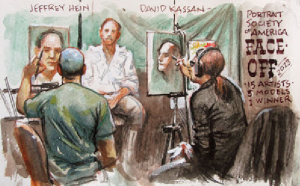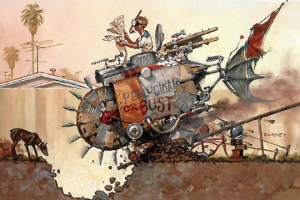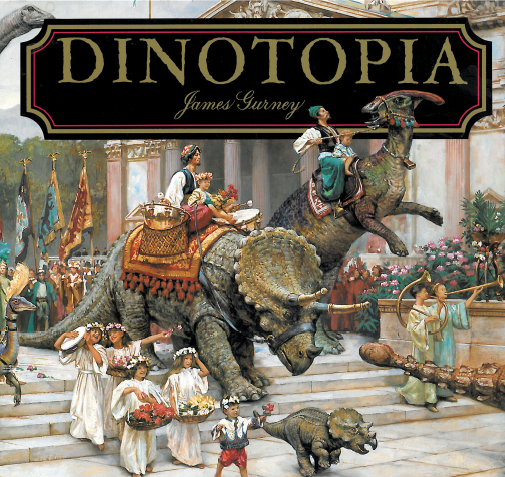The Portrait Society of America (April 2013) held its annual conference in Atlanta and featured illustrator James Gurney. As a parent, I was familiar with his book Dinotopia but had never looked beyond the bedtime story scenario. At PSA’s conference, I chose a Gurney break-out session and began to learn how approachable he was. Gurney showed his to-go-kit, minimal art supplies he takes on the road, to an audience of painters ranging from beginners to the highly skilled.
Gurney has a keen sense of his surroundings which he records with the simplest ingredients: pencils and watercolors, a fountain pen and markers, all rendered in the tiniest sketchbook. He draws with HB and 4B pencils, and preloads water brushes, which I’d never heard of. So I Googled art stores to research this seemingly handy tool. Apparently, you load the water brush’s hollow handle with liquid watercolor and away you go. On location you might need several water brushes loaded with different hues—very convenient and I plan to try some. Gurney gets his to-go supplies into a hiker’s fanny-pack.

OK, I’m a slob when it comes to packing paint and brushes for going on-location. I can’t imagine a sketchbook being smaller than a legal pad or my paint tubes and brushes being carried in anything less than a Home Depot rolling tool box. I don’t think I could even write my grocery list on a Gurney sketch pad, but then I haven’t been endorsed by Dream Works Animation or Johns Hopkins School of Medicine or the Denver Museum of Natural History, either.
Gurney was the key speaker at PSA’s gala and enthralled even those, like my husband Dave, who only uses a paintbrush for touch-ups to the exterior of our house. During PSA’s art weekend, this king of dinosaurs stole around ballrooms unobtrusively drawing visiting artists who demonstrated how to render a figure in paint. The packed audiences eagerly caught the posing models on their iPads while Gurney professed to get as much as much down on his sketch pads using plain observation.
Dinotopia
Dinotopia is celebrating twenty years in print. Gurney has written three sequels which center around nineteenth century biologist Arthur Denison and his adolescent son Will. The two are shipwrecked off the schooner Venturer and land somewhere uncharted. Even more mysterious, everyone on this dinosaur-inhabited island appears to have arrived by shipwreck with no apparent way to leave. For explorer Denison, travelling around Dinotopia with trusty dinosaur sidekick Bix becomes a series of adventures encountering bizarre people and creatures, while becoming fascinated with unique flora and fauna. For Will, Dinotopia becomes a path to manhood, as he begins a tame relationship with a dinosaur rancher’s daughter, the red-headed Sylvia.
Will and Sylvia have their own quests as they become accomplished pilots on dinosaur-esque flying conveyances called Skybaxes. Enough revealing the plot lines that give young readers a taste of how to imagine, similar to more advanced tomes: Harry Potter, Star Wars and Homer’s Odyssey. As Gurney says in the introduction to Dinotopia, “the book you hold in your hands is an odyssey for the eye. You can check with the nearest eight-year old; all the dinosaurs are real, based on fossil evidence. Whether the rest is real depends on you.” Although this tale is very readable, it is the narrative illustrations that keep bedtimers flipping back and forth.
Gurney successfully marries Dinotopia’s story to the pictures as well as his additional diagrams of island mysteries, thus allowing adult readers to become just as enchanted.
Imaginative Realism
Gurney’s extreme attention to detail, often peppered with humorous imagery, is generously explained in his how-to book, Imaginative Realism. As anyone who has begged for someone’s chocolate chip cookie recipe knows, you can mix up a batch of your friend’s morsels, but the results will never be the same. Hence, Gurney has no fear that giving away secrets will result in copycat Dinotopia illustrators.
My art training has been largely couched in abstraction, the dominant genre of Modernism. As the adage goes, Abstraction is always found in the shapes of Realism, which means even the most die-hard devotee of Jackson Pollock can benefit from lessons in representation, as I did when reading Imaginative Realism.
Although Gurney uses a camera, small theater spotlights for rendering shadows, and Photoshop, he explains that modeling with clay, cardboard and even an old pair of pantyhose can produce great maquettes that grow into fantasy locations. These models can stand alone or become focal points for a still life leading to composing multiple paintings or photographs. If you close-read, Imaginative Realism you’ll discover that this modest artist has the stature to call the Jim Henson Creature Shop for assistance.

Gurney feels fantasy needs a ‘lived-in look.’ Even new or make believe civilizations have to deal with yesterday’s detritus. So Gurney builds dents and rust into his robotic concoctions. One example is a Gurney book cover for The Digging Leviathan (1982) which depicts a boy operating pretend earth moving equipment, recycled from old bicycle and umbrella parts. The boy sits atop a trash can wearing a mask and snorkel (eye protection) while steering with an old wood drilling auger.
Gurney travels worldwide, bringing ideas back to his upstate New York studio. Imagery of Salamanca, Spain and Venice eventually become superimposed and morph into Waterfall City, one of Dinotopia’s main drags.
Tremendous research goes into a Gurney work. When constructing a fire fighting dinosaur he consulted Ernesto, a senior product specialist, ‘for a firm that designs and builds modern fire engines.’ Hosing that needs to travel up the neck of a dinosaur must be properly fastened so firemen who ride these creatures don’t get knocked around by the force of water rushing through heavy hoses. Ernesto applied physics to dinosaur anatomy and cleverly affixed both hosing and ladders to Gurney’s mythical firefighting apparatus.
Gurney has illustrated bygone civilizations for National Geographic, photography would be impossible. When reconstructing an Etruscan iron works, circa 700 B.C., he consulted an archeologist to get primitive smelting techniques, placing rows of chimneys authentically on the Populonia Beach. In keeping with his adage that nothing should look perfect, he renders an Etruscan foreman daydreaming as he leans on his staff while supervising sweating grunts. As Gurney quips, “it always struck me that paintings of work scenes show everyone looking too earnest and industrious.”
Gurney believes artists, especially young ones, should, “study nature as faithfully as possible and portray it with as few mannerisms as possible.” This may not go down well with those who like to be Impressionistic. However, this method proved fruitful to Gurney who was asked by the US Postal Service to create Jurassic scenery on stamps. Of course he had the authoritative green light to consult scientists about plants and dinosaurs. But, he also did research at Brooklyn’s Botanical Garden. Although he shows what renowned artists have at their disposal, he also provides information for the “average Joe” artist.
Gurney is curious and digs deeper. What do viewers initially gravitate to when first looking at his work? For this, he consulted Eyetools. Did you know it takes 3½ seconds to zone in on context and detail? And apparently no two people visually scan in the same way. Gurney subjected his paintings to heatmapping which revealed that ‘sharp detail or strong tonal contrasts’ don’t necessarily attract a viewer the way the canon of art teaching has insisted. Aha…maybe those judges didn’t award you that prize because they didn’t see your work the way you did!
And Gurney never wastes time. Once when waiting for his clothes to dry, a parking lot outside the laundromat became his studio much to the astonishment of another mall attendee who said, “I’ve lived here twenty-five years and I’ve never seen an artist painting the CVS.”
Some Gurney neighbors don costumes and morph into storybook characters while others become stand-ins for dinosaurs. Here, Gurney often resorts to quick snapshots, making up for fidgety drama queens. Like magic (or is it?), friends begin to look more and more like their Gurney portrayals.
I love acrylics; I might try some acrylic modeling paste mixed with matte medium the next time I need texture. And I think I’ll buy one of those small stage lights too. Even if you are never going to design a video game or illustrate a sci-fi paperback book cover, it doesn’t hurt to know what other artists can accomplish.
Imaginative Realism can be read as a companion to the Dinotopia series or can stand alone as an artist’s reference; it’s clear and instructive. Gurney nicely situates himself and his readers on art’s timeline by referencing masters like Rembrandt or illustrators like Norman Rockwell. He insists it is not the name brand art school that will make you famous and, “never be afraid of teaching yourself.”
The Art of James Gurney: Part 2 will appear on Town Square 49 in October. The Dinotopia series and Imaginative Realism are available on Amazon. Gurney is a contributor to International Artist Magazine; his blog Gurney’s Journey can be Googled.






